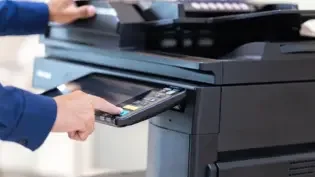The Small Business Owner’s Guide to Restaurant Financing
By: Wagepoint

Running a restaurant can be hectic—and when it comes to maintaining positive cash flow, you might be feeling the heat.
Business funding may be the answer to keeping things running smoothly. In this guide, we’ll explain:
- How you can put financing to use for your restaurant.
- Factors to consider when weighing your restaurant loan choices.
- Ten different options for restaurant financing.
Ready to dive in? Here we go!
Why would your restaurant need a loan?
The reasons for using a financing option for your restaurant are as varied as your menu. You may already have a specific idea of why you want to pursue funding—but if not, here are seven areas a loan can help address:
1. Equipment purchase or repair
Having the right equipment is critical for keeping the doors open and your customers happy. But coolers, ranges, deep fryers, and other equipment can be pricey to maintain and upgrade. With restaurant financing, you can invest in up-to-date equipment or make the necessary repairs to prolong the life of your existing kitchen appliances.
2. Unexpected costs
Running a restaurant means dealing with the occasional curveball. If your HVAC system dies or the power goes out, you’re left with a lot of spoiled inventory. A restaurant loan can help you handle the unexpected expenses without having to dip into your cash reserves.
3. Inventory and supplies
There are certain must-haves your restaurant needs to run smoothly. From the ingredients that go into your best-selling dishes to silverware and linens, the list is lengthy. Whether you’re stocking up on day-to-day supplies or prepping for a seasonal rush, restaurant financing can help you cover all the necessities.
4. Marketing
Word-of-mouth can be a powerful way to grow your business organically. But at some point, you may be ready to experiment with different marketing strategies. For example, you want to rent a billboard, create digital ads, or film a TV commercial. All those options take money that a business loan can help cover.
5. Renovations or expansion
At some point, you might decide your restaurant needs a facelift. Or you may be growing so fast that opening another location is necessary to keep up with the pace. Here’s where a restaurant loan can come in handy. You can use financing to pay contractors, purchase furniture and equipment, or cover your lease payments in the short-term.
6. Restaurant software subscriptions and upgrades
Bringing yourself into the 21st century with business software can make you more efficient and boost your bottom line. Say it’s time to upgrade your point-of-sale system or revamp your payroll processing (with something like Wagepoint). Being able to finance the latest restaurant tech innovations can streamline your back-office processes and keep you focused on the day-to-day of running your restaurant.
7. Relocation
Picking up and moving house can be an overwhelming task, but it may be a necessity if you’re not getting enough traffic or your lease payments are too high in your current location. You can use a loan to handle all the costs of getting your restaurant relocated from point A to point B.
How do you know if it’s right to take out a restaurant loan?
Just because you have a monetary need for one of the expenses listed above, doesn’t mean taking out a loan is the right financing choice. It really depends on how much you need versus what cash you already have available to you.
Determine the return on investment (ROI)
No matter the reason for financing, it’s helpful to calculate the ROI on a loan before taking it on.
First, consider what a loan will cost you in terms of interest and fees. Obviously, the lower your interest rate is, the better. Then, compare that figure to the amount of return (value) you expect to get based on how you plan to use the loan funds.
Here’s a rough example:
You borrow $250,000 to open a second location. You get a five-year loan with a 6% annual interest rate. The total interest paid on the loan over five years would come to about $40,000, which breaks down to about $8,000 per year.
Now, assume that opening the second location would increase profits by $20,000 annually. Multiply that by the five-year life of the loan, and you’re looking at an additional $100,000 in revenue. Even when you deduct the interest paid on the loan, you’re still ahead by $60,000. Taking the loan on, in this case, would make sense.
If you’re paying a substantial amount of interest but only moving the needle slightly to increase profitability, a loan may not be your best option. Running the numbers is a great way to get perspective on determining if a shiny new expense is actually worth it.
Consider the size and necessity of the loan
If you’re not looking to cover a significant cost with financing, it can be better to use your reserve of cash instead. If it only costs a few hundred dollars to fix a piece of critical equipment and you have the necessary cash on hand, it wouldn’t make sense to take out a loan to cover it.
Also, thinking about the severity of the need is crucial as well. Taking out a huge loan for something that is not really necessary (and doesn’t have great ROI potential) isn’t the best business move. But covering a sudden expense that’s vital to your day-to-day operations may require financing.
Either way, you should try your best to avoid taking loans out unless it’s vital. That way, you won’t be straining your cash flow with extra payments and interest fees.
How much money do you need to borrow for a restaurant loan?
It’s really important to understand how much money your situation warrants before taking out a loan. Take on too much financing and you’re paying interest on money you don’t need. On the flip side, getting a loan that’s too small means trouble down the line and needing additional financing to fill the gap.
This is where being clear on your purpose for getting the loan becomes important. When you have a detailed punch list of expenses to follow, it’s easier to accurately estimate how much money you need to borrow.
Let’s go back to the previous example of opening a new location. The list of expenses involved includes:
- Paying your initial lease at the new location or purchasing the location outright
- Getting all the licenses and permits required to operate
- Buying back- and front-of-house equipment
- Purchasing inventory and supplies
- Hiring and training new staff
- Covering utilities for the first few months
- Paying for marketing and advertising to get the word out
- Meeting payroll for your staff
You might have a big-picture vision of what you want to do with financing, but it’s important to drill down to the nuts and bolts (and dollar figures). This way, you cut down on the odds of overlooking a key expense.
Other factors to consider with restaurant financing
Once you’ve gotten a handle on what you want to use a restaurant loan for and how much you’ll need to borrow, you now have to choose a loan that has terms that work for you. These additional factors can vary from bank to bank, and consequently affect if the loan is worth it.
Repayment terms
When you’re considering a loan, ask yourself what kind of repayment terms would work best. Think about how long you’re comfortable stretching out repayment and how much of your cash flow you want to commit to loan repayment each month.
Be realistic here when considering the interest rate you’re likely to qualify for based on your credit and financial history. A lower rate can translate to a lower monthly payment, but not everyone will be lucky enough to qualify. If you haven’t checked your credit lately, you should definitely put it on your to-do list.
Take time to compare the rates different lenders offer, as well as additional charges they have. Be on the lookout for things like origination fees, prepayment penalties, and late fees, all of which can add to your total cost of borrowing.
Application process
Applying for a business loan can be time-consuming but you can make it easier by being organized. Create a checklist of documents you’ll need to apply, then gather those together before you start the loan process.
The documents a lender is likely to ask for include:
- Business and personal tax returns for the previous two years
- Business and personal bank statements for the previous two to three months
- Recent profit and loss statement
- Recent cash flow statement
- Recent balance sheet
If you’re applying for a secured loan, you should also be prepared to offer proof of collateral. For example: If you’re pledging a piece of property you own for a loan you may need a copy of the title or deed to show the lender.
Keep in mind the application process may be more streamlined with certain lenders than others. With an online lender, for instance, you may be able to apply for a loan and upload your documents in just a few minutes.
Speed of funding
Depending on what you need restaurant financing for, speed may be of the essence. If you’re shopping around at different lenders, check how long it takes for a loan to be funded once you’re approved. There can be a big difference between waiting a few days to receive funding versus a few weeks if you have a pressing financial need.
10 ways to finance your restaurant or bar
When you’re comparing financing options, there are two broad categories to consider: Debt and equity. With debt financing, you’re agreeing to repay a certain amount of money to a lender over time. You may or may not have to offer collateral and/or a personal guarantee for the loan.
Equity financing is different. You’re not borrowing from a lender—instead, you’re allowing investors to fund your business in exchange for an ownership share in your restaurant. The upside of equity financing is that there’s nothing to repay, even if the business doesn’t succeed. The downside is that you’re sacrificing full control of your business.
Here are some different debt and equity financing avenues you could use to grow your restaurant.
Debt financing
- Term loans
When you get a term loan, you’re borrowing a lump sum of money that you agree to repay over a set period of time. Term loans can have fixed or variable interest rates and you may be able to borrow anywhere between $5,000 and $2 million. The typical sweet spot for a term loan is $25,000-$500,000, with a repayment period of one to five years.
- SBA loans
The Small Business Administration (SBA) doesn’t offer loans directly, but it does guarantee loans issued by partnered lenders. The microloan program offers up to $50,000 in funding, often geared toward startups and newer businesses. With the 7(a) loan program, you could borrow up to $5 million. Loan repayment can extend up to 25 years, depending on what the loan is used for.
- Equipment loans
This type of loan is designed for purchasing or leasing equipment. The equipment usually serves as collateral for the loan, and it’s possible to get 100% financing (although some lenders may require a down payment). The repayment period for equipment loans can be tailored to fit the usable lifespan of the equipment you’re buying.
- Inventory financing
Inventory financing is a short-term loan option that you can use to buy inventory as needed. Like equipment financing, the inventory serves as the collateral for the loan and you may be able to finance anywhere from 80-100% of the purchase. The idea with this kind of financing is as you sell the inventory purchased, you’ll generate the cash flow to repay the loan.
- Merchant cash advance
A merchant cash advance is another type of short-term loan. With this kind of financing, you’re pledging to repay the loan from your future debit and credit card receipts. Merchant cash advances can be quick and convenient—but pay attention to the cost. The effective APR can easily land in the double- or even triple-digit range.
- Business line of credit
A business line of credit can give you flexible funding for your restaurant. Instead of a lump sum, you’re getting a revolving line of credit to draw on as needed. You only pay interest on the amount of your credit line you’re using. One thing to know, however, is a business line of credit is harder to qualify for if you have bad credit.
- Working capital loan
A working capital loan can be used for a variety of purposes, from managing payroll to covering quarterly or annual insurance premiums. This kind of financing is meant to be used for short-term needs, rather than long-term growth.
Equity financing options
- Crowdfunding
Crowdfunding is a way to raise money for your business from multiple, usually smaller investors. You can post a request for funding through a crowdfunding platform, and individual investors decide how much to pony up on your behalf. Be aware of any fees a crowdfunding platform charges.
- Borrowing from investors
If you’re looking for a more formal investing route, you can use a multitude of loan options from investing individuals or organizations. There are tons of different types of formal funding you can tap into—angel investors, venture capitalists, peer-to-peer—each with their own set of expectations and level of involvement. This type of option is best for long-term growth plans like opening a new location, and not for short-term financing.
- Borrowing from friends and family
Lastly, you can ask your friends and family to support your restaurant business by investing money. The tricky part is ensuring you’re maintaining clear boundaries when it comes to your personal relationship and your business relationship.
Make your finances work for you
Whether you find yourself strapped for cash or it’s time to take your business to the next level, a restaurant loan could be the missing ingredient. Knowledge is power, and understanding the financing process and options available to you is crucial to making the best decision for your operation.
The information on our blog is intended to be informational. It does not replace the expertise of accredited business professionals.
Author: Samantha Novik is a content marketing writer covering business and finance for Funding Circle, a business loan provider in the US.












